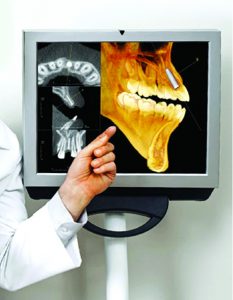 One of the most amazing developments in the field of dentistry is the dental implant. Dental implants are used to replace missing or broken teeth. This option truly can help a patient achieve both the appearance and function of teeth that have been lost. Advanced technology, called Computer Guided Implant Surgery, has now made the actual placement of the implant much less invasive leading to greatly reduced (if any) discomfort after the procedure.
One of the most amazing developments in the field of dentistry is the dental implant. Dental implants are used to replace missing or broken teeth. This option truly can help a patient achieve both the appearance and function of teeth that have been lost. Advanced technology, called Computer Guided Implant Surgery, has now made the actual placement of the implant much less invasive leading to greatly reduced (if any) discomfort after the procedure.
In order to understand the procedure it is important to understand the dental implant itself. Very simply, a tooth has 2 parts: a root (that holds the tooth in the bone) and a crown (that is seen in the mouth). When a tooth is removed, an empty socket remains in the bone.
A replacement root, called a dental implant, can be placed in this site. The implant itself is not visible in the mouth and over time becomes one with the bone surrounding it. A number of months later a connection can be added to the implant so that crown can be made (just like a crown is made on a tooth root) to complete the entire tooth.
Traditional Implant Surgery:
Implants are usually planned by the surgeon using a combination of a clinical evaluation and a careful examination of dental x-rays. These x-rays are helpful, but have the limitation of only showing a 2-dimensional view of the area. Typically the “width” and exact locations of important structures such as nerves cannot be determined.
CT scans offer a significant improvement in the detail provided to the surgeon when planning the procedure.
In-office CT scanning takes typically less than a minute and involves sitting in a chair while the unit rotates around your head. The scan offers a 3-D view of the structures being evaluated. The views are similar to slicing a loaf of cinnamon raisin bread and seeing the exact detail of each slice. In the CT scan, nerves, sinuses and other important anatomy can be identified with a high degree of precision. This information allows the procedure to be planned in the most conservative and safest manner. Once the treatment has been planned, the procedure is performed by opening the gum tissue and inserting the implant into the desired location. Sutures are typically used to close the surgical area.
Computer CT Guided Implant Surgery:
Guided Implant Surgery allows your procedure to be “performed” in advance of the actual surgery. The majority of the work occurs when you are not in the dental office. Once the CT scan is taken, advanced computer programs are used to “perform the surgery” and place implants within the 3D representation of your mouth in the safest and most ideal positions. These implant positions can be shared in advance with your general dentist so that the overall treatment is ideal. In a very oversimplified example, the programs used are similar to a very advanced video game with full representation of your jaws and all the implants available to an exact scale. Ideal placement location and implant size selection can be determined using this software.
A surgical guide is created that only allows the surgeon to place the implant in the predetermined locations. The technology lets the surgeon perform the procedure without the need for typical incisions and suturing. This conservative approach typically leads to decreased pain, swelling and a more streamlined recovery. Improved safety can often be achieved around nerves and sinuses with the use of this procedure. The state-of-the-art procedure can be used for patients requiring 1 implant to patients in need of full mouth rehabilitation.
This technology has drastically changed the way dental implant surgery can be planned and performed with improved preciseness and typically decreased pain. The procedure is not applicable for every case and needs to be determined by your surgeon on an individual basis. Shorter treatment times, increased safety and decreased pain are patients’ most frequent comments regarding this type of therapy. The answer is yes, dental implant placement can be performed in 15 minutes.
Lee R. Cohen, D.D.S., M.S., M.S., is a Dual Board Certified Periodontal and Dental Implant Surgeon. He is a graduate of Emory University and New York University College of Dentistry.
Dr. Cohen completed his surgical training at the University of Florida / Shands Hospital in Gainesville, Florida. He served as Chief Resident and currently holds a staff appointment as a Clinical Associate Professor in the Department of Periodontics and Dental Implantology. Dr. Cohen lectures, teaches and performs clinical research on topics related to his surgical specialty.
The focus of his interests are conservative approaches to treating gum, bone and tooth loss. He utilizes advanced techniques including the use of the Periolase Dental Laser (LANAP procedure) to help save teeth, dental implants, regenerate supporting bone and treat periodontal disease without the use of traditional surgical procedures. Additionally, Dr. Cohen is certified in Pinhole Gum Rejuvenation, which is a scalpel and suture free procedure to treat gum recession with immediate results.
Dr. Cohen uses in-office, state of the art 3D CT imaging to develop the least invasive dental implant and bone regeneration treatment options. Dr. Cohen and his facility are state certified to perform both IV and Oral Sedation procedures. Botox® and Dermal Fillers are also utilized to enhance patients’ cosmetic outcomes.
Dr. Cohen formerly served on the Board of Trustees for the American Academy of Periodontology and the Florida Dental Association. He is past president of the Florida Association of Periodontists and the Atlantic Coast District Dental Association. Dr. Cohen is a member of the American College of Maxillofacial Implantology and the American Academy of Facial Esthetics. In addition, he has been awarded Fellowship in the American College of Dentists, International College of Dentists and the Pierre Fauchard Academy.
www.PBCPERIO.com
561-691-0020
Check Also
WHAT IS MY CIRCADIAN RHYTHM AND WHY DOES IT MAKE ME FEEL SO “OFF”
By Renee Chillcott, LMHC Have you heard terms such as “biological clock” or “biorhythms”, or …
 South Florida Health and Wellness Magazine Health and Wellness Articles
South Florida Health and Wellness Magazine Health and Wellness Articles




